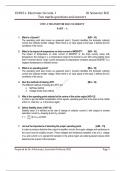EC8351- Electronic Circuits- I III Semester ECE
Two marks questions and answers
UNIT–I TRANSISTOR BIAS STABILITY
PART – A
1. What is a Q-point? [N/D– 16]
The operating point also known as quiescent point ( Q-point) identifies the transistor collector
current and collector-emitter voltage. When there is no input signal at the base, it defines the DC
conditions of the circuit.
2. What is the impact of temperature on drain current of MOSFET? [N/D– 16]
The impact of temperature on drain current of MOSFET is, the drain current varies with
temperature; the change in ID in temperature range for N-channel is over 20% being slightly lower
than P-channel device. Drain current decreases as temperature increases because MOSFET is a
negative temperature co-efficient device.
3. What is an operating point? [M/J– 16]
The operating point also known as quiescent point ( Q-point) identifies the transistor collector
current and collector-emitter voltage. When there is no input signal at the base, it defines the DC
conditions of the circuit.
4. Give the methods of biasing JFET. [M/J– 16]
Self bias method
The different methods of biasing the JFET are
Voltage divider bias method
5. Why is the operating point selected at the centre of the active region [N/D-15]
In order to get the faithful amplification of the signals, operating point has to be fixed at the middle
of the d.c. load line. i.e. in the active region.
6. Define Stability factor [ N/D-15]
Stability factor S is defined as the rate of change of collector current IC with respect to reverse
saturation current ICO keeping β and VBE constant
�
= |β, V constant
� �
7. List out the importance of selecting the proper operating point. [A/M – 15]
In order to produce distortion-free output in amplifier circuits, the supply voltages and resistances in
the circuit must be suitably chosen. These voltages and resistances establish a set of d.c. voltage
VCEQ and current ICQ to operate the transistor in the active region are called quiescent values which
determine the Q-point of the transistor.
Prepared by Dr. A.Devasena., Associate Professor/ECE Page 1
,EC8351- Electronic Circuits- I III Semester ECE
Two marks questions and answers
8. Draw a DC load line of the circuit show in Figure 1. [A/M – 15]
Given :
Vcc = 10V, RB = 120 kΩ, RB = 12 kΩ, hfe = β =125
For drawing dc load line, the two end points viz maximum V CE point (at IC = 0) and maximum IC point
( at VCE = 0) are required.
Maximum VCE = VCC = 10 V
Maximum IC = = = 0.8 mA
∗
Prepared by Dr. A.Devasena., Associate Professor/ECE Page 2
,EC8351- Electronic Circuits- I III Semester ECE
Two marks questions and answers
9. Find the collector and base current of circuit given in fig.2. [N/D– 14]
Given:
hfe = β = 100, VBE(on) =0.7V, Vcc =5 V, RB = 20 kΩ, RC = 10 kΩ
apply KVL to the base circuit,
−� − =
− −
� = =
Ω
� = �
� = �
� = ∗ � = .
10. What are the operating regions of N-Channel MOSFET and how do you identify the operating
region? [N/D– 14]
The operating regions of N- channel MOSFET are
Cutoff region
Ohmic region
Active region
Saturation region
11. Define – Stability Factor [May/June – 12], [Nov /Dec – 09],
[April/May –10], [May/June – 12]
i. Stability factor is defined as the rate of change of collector current I C with
respect to the collector base leakage current I CBO keeping both VBE and the
current gain constant.
Prepared by Dr. A.Devasena., Associate Professor/ECE Page 3
, EC8351- Electronic Circuits- I III Semester ECE
Two marks questions and answers
�
Sʹ = �
, with , VBE constant
ii. Stability factor indicate the degree of change in operating point due to variation
in temperature.
�
Sʹ = , with , ICO constant
�
�
Sʹʹ = |, with VBE, ICO constant
��
12. Why do you fix the operating point in the middle of the dc load line? [Nov 05]
In order to get the faithful amplification of the signals, operating point had to be fixed in
the middle of the dc load line.
13. What is Bias? What is the need for biasing? [ Nov-08, May-09,Nov-10, May-11,
May-13]
The proper flow of zero signal collector emitter supply voltage during the passage of
signal is known as transistor biasing.
Alternatively, the process of giving proper supply voltages and resistances for obtaining
the desired Q-point is called biasing.
The need for biasing is
To prevent thermal runaway
To achieve stability
14. Why capacitive coupling is used to connect a signal source to an amplifier?
[Nov/Dec-07]
Coupling capacitor blocks DC voltage but freely pass signal voltages. Because of this
biasing conditions are maintained constant.
15. Compare bias stabilization and compensation techniques. [Nov /Dec – 11]
BIAS STABILIZATION BIAS COMPENSATION
It refers to the use of resistive biasing It refers to the use of temperature
circuits which allow IB to vary, so as to sensitive devices such as diodes,
keep IC relatively constant with variations transistors, thermistors, etc., which
in ICO, and VBE. provide compensating voltages and
currents to maintain the operating point
stable.
Prepared by Dr. A.Devasena., Associate Professor/ECE Page 4




